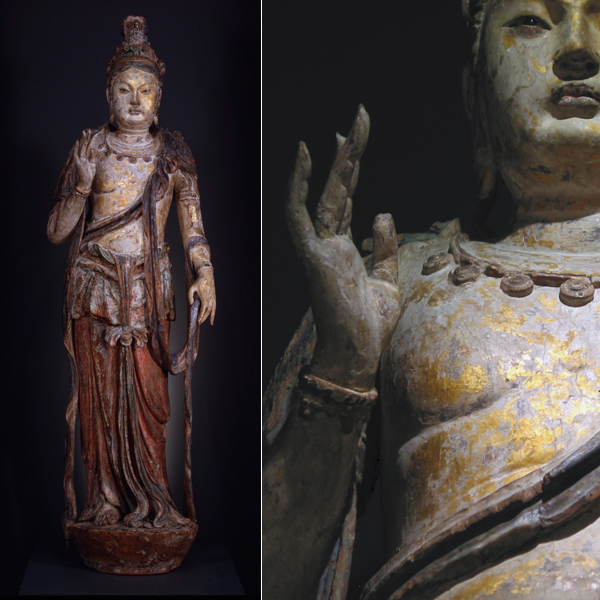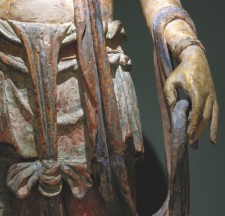
Unknown
Chinese
Bodhisattva of Compassion, Guanyin , 1115-1234 CE
wood with polychrome
64 1/2 x 18 x 15 in.
SBMA, Gift of Wright S. Ludington in memory of Charles Henry Ludington
1983.27.11
RESEARCH PAPER
This sculpture is by an unknown artisan. A number of images of this type exist in China and elsewhere, the result of patronage by the northern Liao and Jin dynasties. The Liao and Jin were Mongols, who conquered northern China in 1127 CE. Eager to extend control, they commissioned large numbers of works of religious art and endowed temples. Please close your eyes, and imagine for a moment, how this must have looked as originally displayed, in a sacred, candle lit space.
Our Guanyin is made of carved wood. She was carved, covered with a light coat of gesso (Plaster of Paris or gypsum prepared with glue) painted and then gilded. This sculpture is remarkably well preserved; most wooden sculptures from this time period are in a more dilapidated condition. There are still traces of vivid reds and blues.
In China, sculpture was not considered a fine art, because it involved physical labor, and therefore was not a proper occupation for a true gentleman. Sculptors were in stead regarded as craftsmen; their names were not important. These sculptures were not created as objects of art, but rather for a specific ceremony, funerary procession/installation, or as in this case, for religious purpose. Like European Baroque sculpture’s that portray religious stories, these emotionally appealing objects were intended to comfort, win and retain converts.
I’d like to spend a few moments addressing the question, who or what is Bodhisattva Guanyin? In Buddhist teachings Bodhisattvas are intercessionary figures, “whose essence is enlightenment”. They are beings that are destined to become Buddhas themselves. In the Chinese Buddhist pantheon, Guanyin is the Bodhisattva of Divine Compassion, “she who perceives [with compassion] the Sounds [of the suffering world].” She is said to have renounced her own salvation and immediate entrance into Nirvana to intercede on behalf of the suffering beings of this world. She is probably the most popular of all Buddhist deities.
In India, Guanyin is known as Avalokiteshvara, the compassionate Bodhisattva and is depicted as male, while in Japan she is known as Kwan on. The worship of Avalokiteshvara (as Kuan-yin) was introduced into China as early as the 1st century CE and had entered all Buddhist temples by the 6th century. Therefore, representations of the Bodhisattva in China prior to the Sung dynasty (960-1126) are masculine in appearance. Later images are female, but subtly, almost imperceptibly so.
Why the sex change? In China, Buddhist iconography and ideas are entwined with Taoism and the Yin/Yang philosophy. Compassion is considered a yin or female quality, so therefore the image takes on female characteristics. Guanyin became identified with his female reflex, Tara, with the ancient Chinese mother-goddess. However, the Chinese Buddhist images are really meant to transcend gender and be a manifestation of the idea, therefore, the gender neutral quality is the ideal since it communicates that this characteristic, although considered yin in the yin/yang dynamic, is a potential which is possessed by both genders and should be fostered in all.
The Chinese aesthetic is in line with the idea that all of the figures are manifestations of concepts and not truly personifications of any one individual or any gender. They are manifestations of the qualities or potential of all humans.
As an agent of Amitabha, the Buddha of Western Paradise, The SBMA Bodhisattva Guanyin has a small image of this Buddha in her headdress. This is the symbol that identifies this statue as Guanyin. The headdress, called an ushinisha, behind the small Buddha is itself the symbol of wisdom.
She has a very lively appearance: her glass eyes glitter and seem to follow you around the room; her body is sensuously modeled; her skin looks soft. You can see here that her left knee is slightly bent with the foot turned outward, and the weight of the body shifted onto the right hip. So despite the fact that she is very linear, carved in a columnar style, with the arms held close to the body to emphasize the architectural effect, we almost feel as if she is about to step down from her pedestal.
Her softly rounded face makes an interesting contrast to the graceful linear geometry of her features. It’s a fleshy, somewhat sensual face, and yet at the same time her expression is serene, removed from stress and struggle. Her ear lobes are split and elongated, recalling the form of heavy jeweled earrings that would have split and pulled down on the ear lobes. All Buddhist figures have these elongated earlobes to symbolize the historic Buddha’s Prince Siddhartha’s renunciation of all worldly riches to pursue inner peace.
The hands are in the position of traditional Mudras, or symbolic gestures. The position of the right hand, turned out to show the palm with the fingers relaxed is the Abhaya Mudra. This tells us that she soothes and calms. The left hand, holding the edge of the looped scarf with the index finger touching the thumb and the other fingers pointing to the ground is the Vitkarka Mudra, the sign of wisdom grounded in the earth.
The slight forward inclination of the figure indicates good will.
Her pedestal originally included the petals of a lotus blossom, the symbol of everlasting life.
Her clothing or draperies are also of a linear design. The scarves and ribbons: now but tattered remnants of former fine court robes flow over the surface of the sculpture, curving across the body, over the back and looping up to the left hand. This rhythmic movement of line enhances the impression that she might step forward with stately ease, and is transmitted directly to sculpture from the traditions of Chinese painting. In the actual carving the folds are deep, with sharp edges, so that a dramatic contrast is obtained between highlight and shadow.
She is the personification of divine compassion.
Prepared for the SBMA Docent Council by Laura DePaoli
POSTSCRIPT
• When in 1114 the Juchen Tatars in the far northwest revolted against the Khitan, the Chinese army helped the rebels destroy their old enemy. The Juchen then turned on the Sung, invaded China, besieged the capital in 1126, and took the emperor Ch'in-tsung, the emperor emeritus Hui-tsung, who had recently abdicated, and the Imperial court prisoner, establishing their own dynasty, the Chin, with their capital at the city later to be called Peking.
• When the Khitan fell, their power in China was taken over and extended by the Juchen (Jürched), a Tungus people based farther north in northeastern China. They took the Chinese name of Chin ("Golden"). In their tribal policy they switched their favor from "All the Mongols" to the Tatars (known in the West as Tartars, from a medieval pun on tartarus, Latin for "hell"). Although Mongols, the Tatars were not part of the tribal league of All the Mongols, centered in the Onon and Kerulen valleys in the eastern half of North Mongolia; the Tatars lived to the east and south of them.
• On attributes of both genders: One interpretation of this development contends that the bodhisattva is neither male nor female but has transcended sexual distinctions, as he has all other dualities in the sphere of samsara (the temporal world). According to this opinion, the flowing drapery and soft contours of the body seen in statues and paintings have been intentionally combined with a visible moustache to emphasize the absence of sexual identity. Furthermore, the LotusSutra relates that Avalokiteshvara has the ability of assuming whatever form is required to relieve suffering and also has the power to grant children.
• The popular devotional cult of Kuan-yin has superimposed onto the bodhisattva qualities of the Chinese mother-goddess, Tara and Guanyin is associated with aid in conception and childbirth. A center of the personal worship of the savior Kuan-yin is the island of P'u-t'o near Ning-po (associated with the traditional mountain residence of the bodhisattva Potala).
http://www.britannica.com/

SBMA CURATORIAL LABELS
Guanyin, literally “Sound Observer,” (“Avalokitesvara” in Sanskrit) is the Bodhisattva of Compassion, who answers all prayers and protects the faithful from calamities. He is identified by the small figure of Amitabha Buddha in his headdress. This figure and the seated Guanyin in the SBMA collection are two of the few surviving wooden sculptures from the 12th and 13th centuries, a time when the growing popularity of Buddhism led to more humanized portrayals of deities.
- Ridley-Tree Gallery, 2016
